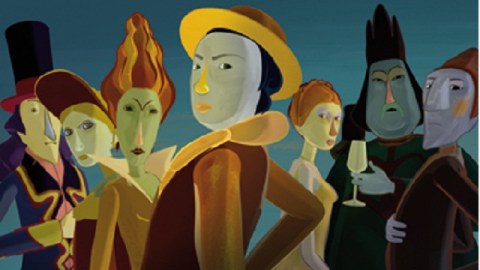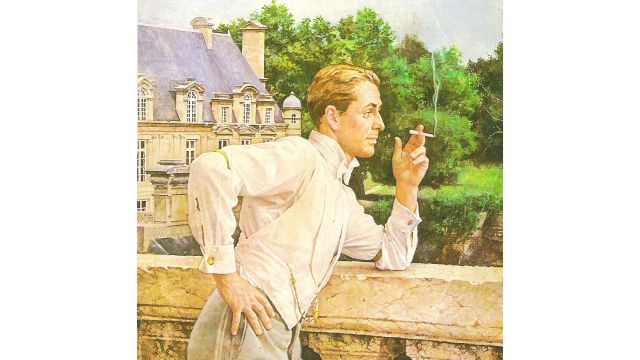An Animated Parable of Painting

What really matters in an art education? Do we teach every child to paint or sculpt? Do we school them in names and dates and places? Or do we somehow teach them the elusive and dangerous “truth” of what art is or should be? Jean-Francois Laguionie’s animated film The Painting (Le Tableau), distributed across the United States this month by GKIDS, Inc., uses the ages-old technique of allegory combined with the modern wonder of animation to tell the truth of what making and appreciating art really is. Dazzlingly designed, rapturously rendered, and devastatingly direct, The Painting pictures for an impressionable audience how art makes us more ideally human by making the medium itself move.
The 74-year-old French animation auteur Jean-François Laguionie drew passionately from an early age, eventually studying with legendary French animator Paul Grimault and learning the craft in Grimault’s workshop for a decade. Laguionie opened his own studio in 1979, where he and his crew have created many shorts but only four feature-length films, with The Painting being the fourth when it was released in 2011 as Le Tableau in his native France. It’s taken two years for The Painting to come to the U.S., but it’s well worth the wait.
The Painting presents the world inside a painting left unfinished by the painter for unknown reasons. Inside the painting exist three separate castes: the Alldunns (completed figures), the Halfies (partially completed figures), and the Sketchies (rough drawings of figures). Imagine a visual equivalent to George Orwell’s Animal Farm where, instead of “Four legs good, two legs better!”, worth of an individual is based on whether or not the painter decided to make you complete. When the Alldunns (shown above in a still from the film) explain the “logic” behind the idea of their superiority as more perfect than the scorned Halfies and the enslaved Sketchies, you hear echoes of every other racist explanation for one group excluding or exploiting another.
Laguionie paints his parable in much broader strokes than Orwell, but being less politically detailed than Orwell’s never a crime. Laguionie aims for a young audience in his parable, but not one young enough to be disturbed by the very realistic animated violence of the hate crimes committed by the Alldunns. Animation too often equals childlike in our Disney-fied imaginations, but The Painting’s more appropriate for a 7 or 8 year old with close supervision, but definitely not for children under 6. Laguionie’s talking about seriously ugly stuff here in a visually beautiful way, so being able to understand and appreciate both aspects is vital in comprehending The Painting.
The journey at the heart of The Painting begins with the classic case of two star-crossed lovers: the Alldunn Ramo and the Halfie Claire. When Ramo pleads with his fellow Alldunns to accept the Halfies and Sketchies, the leader of the Alldunns sees Ramo as a threat to his position and has him seized. Ramo breaks free and ends up with another Halfie named Lola and a Sketchie named Quill as they all journey past the edge of the painting and eventually find themselves in the studio of the missing Painter. Joined by Magenta, a red-clad drummer boy from another painting depicting a war of Reds versus Greens, the foursome climb and leap through other paintings by the missing Painter—a voluptuous nude, a carnival scene, and a grumpy self-portrait of the painter himself.
These four characters in search of a Painter (all apologies to Luigi Pirandello) are, of course, searching for god. Does god exist? More importantly, if he exists, does he care? Ramo wants to find the Painter and ask him to finish painting the Halfies and Sketchies to bring peace and equality to their world, but the character of Lola adds a more heartening sense of self-acceptance to the drama. She’s a Halfie only in the eyes of others. In her eyes, the Painter made her exactly the way she should be. Similarly, someone suggests that the Sketchies aren’t unfinished figures but rather preliminary, working sketches—the first ancestors of the Alldunns. When The Painting ventures deepest into epistemology, the younger set may tune out, but the adults will get the message.
But it’s this deep kind of knowledge that The Painting conveys in its own way best to impressionable minds. I recently mused whether director Gilles Bourdos’ film, Renoir, is the greatest film about painting ever. Renoir made you feel like you were right there as the painting was made. Similarly, The Painting makes you feel like you know why the painting was made. If god is the creator, then we can be creators, albeit on a much smaller scale, through art. Art is an act of faith that what is inside us is worthy of sharing as well as of faith in others to accept us and our creations as we accept theirs. The Painting boils down to the Golden Rule, the simultaneously multi-denominational and non-denominational maxim to treat others as we want to be treated ourselves. The Painting’s a gesture of faith in humanity that if we follow that rule, religion (and god, for that matter) is unnecessary. If The Painting can teach kids (and adults) that simple truth, then that’s all the arts education necessary.
“What will we say if we find him?” one of the characters asks as they search for the Painter. The real question Laguionie asks is, “Why search outside ourselves for what we already possess inside?” The Painting (Le Tableau) wraps this message in a sumptuous package full of subtle nods to Picasso, Matisse, Modigliani, Monet, Manet, and a score of other artists that adds up to a beautiful film reminding us not just of the beauty of art, but also the importance of art to making us more accepting, more generous, and more human.
[Image: Still from The Painting (Le Tableau), a film by Jean-Francois Laguionie, distributed by GKIDS, Inc., in the United States.]
[Many thanks to GKIDS, Inc. for providing me with the image above from, a screener’s copy of, and other press materials related to The Painting (Le Tableau), which opened in New York City on May 10th and will expand to Los Angeles, San Francisco, Boston, Atlanta, and other cities beginning May 24th.]





